
The Cooper bomb was a British 20 pound bomb used extensively in World War I, it was the first high explosive bomb to be adapted by the Royal Flying Corps. [1]

The Cooper bomb was a British 20 pound bomb used extensively in World War I, it was the first high explosive bomb to be adapted by the Royal Flying Corps. [1]

The bomb was 24 lb (11 kg) in weight, of which 20 lb (9 kg) was the bomb casing and 4 lb (1.8 kg) was an explosive charge of Amatol. [2] The main body, being 5⁄16 inch (8 mm) thick, was made of cast iron, steel or semisteel [3] and the after body is made of wood and the fins sheet steel. [4]

RDX (abbreviation of "Research Department eXplosive" or Royal Demolition eXplosive) or hexogen, among other names, is an organic compound with the formula (CH2N2O2)3. It is white, odorless and tasteless, widely used as an explosive. Chemically, it is classified as a nitroamine alongside HMX, which is a more energetic explosive than TNT. It was used widely in World War II and remains common in military applications.

Cordite is a family of smokeless propellants developed and produced in Britain since 1889 to replace black powder as a military firearm propellant. Like modern gunpowder, cordite is classified as a low explosive because of its slow burning rates and consequently low brisance. These produce a subsonic deflagration wave rather than the supersonic detonation wave produced by brisants, or high explosives. The hot gases produced by burning gunpowder or cordite generate sufficient pressure to propel a bullet or shell to its target, but not so quickly as to routinely destroy the barrel of the gun.

The GBU-43/B Massive Ordnance Air Blast is a large-yield bomb, developed for the United States military by Albert L. Weimorts, Jr. of the Air Force Research Laboratory. It was first tested in 2003. At the time of development, it was said to be the most powerful non-nuclear weapon in the American arsenal. The bomb is designed to be delivered by a C-130 Hercules, primarily the MC-130E Combat Talon I or MC-130H Combat Talon II variants. The bomb's name and nickname were inspired by Iraqi president Saddam Hussein's invocation of the "mother of all battles" during the 1991 Gulf War.
The Mark 82 is a 500 pound unguided, low-drag general-purpose bomb, part of the United States Mark 80 series. The explosive filling is usually tritonal, though other compositions have sometimes been used.
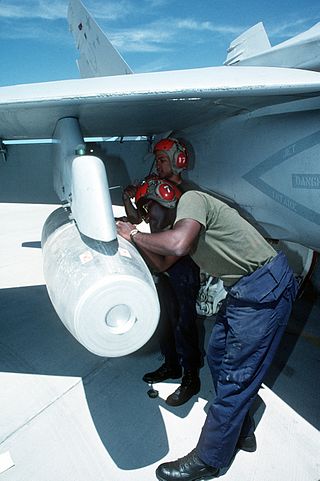
Incendiary weapons, incendiary devices, incendiary munitions, or incendiary bombs are weapons designed to start fires or destroy sensitive equipment using fire, using materials such as napalm, thermite, magnesium powder, chlorine trifluoride, or white phosphorus. Though colloquially often known as bombs, they are not explosives but in fact are designed to slow the process of chemical reactions and use ignition rather than detonation to start or maintain the reaction. Napalm, for example, is petroleum especially thickened with certain chemicals into a 'gel' to slow, but not stop, combustion, releasing energy over a longer time than an explosive device. In the case of napalm, the gel adheres to surfaces and resists suppression.

Unexploded ordnance, unexploded bombs (UXBs), and explosive remnants of war are explosive weapons that did not explode when they were employed and still pose a risk of detonation, sometimes many decades after they were used or discarded. When unwanted munitions are found, they are sometimes destroyed in controlled explosions, but accidental detonation of even very old explosives also occurs, sometimes with fatal results. A dud is an unexploded projectile fired in anger against an enemy, but which has failed to explode. A projectile not fired in anger but which has failed to explode is called a 'blind'.

The Butterfly Bomb was a German 2-kilogram (4.4 lb) anti-personnel submunition used by the Luftwaffe during the Second World War. It was so named because the thin cylindrical metal outer shell which hinged open when the bomblet deployed gave it the superficial appearance of a large butterfly. The design was very distinctive and easy to recognise. SD 2 bomblets were not dropped individually, but were packed into containers holding between 6 and 108 submunitions e.g. the AB 23 SD 2 and AB 250-3 submunition dispensers. The SD 2 submunitions were released after the container was released from the aircraft and had burst open. Because SD 2s were always dropped in groups the discovery of one unexploded SD 2 was a reliable indication that others had been dropped nearby. This bomb type was one of the first cluster bombs ever used in combat and it proved to be a highly effective weapon. The bomb containers that carried the SD 2 bomblets and released them in the air were nicknamed the "Devil's Eggs" by Luftwaffe air and ground crew.

A blockbuster bomb or cookie was one of several of the largest conventional bombs used in World War II by the Royal Air Force (RAF). The term blockbuster was originally a name coined by the press and referred to a bomb which had enough explosive power to destroy an entire street or large building through the effects of blast in conjunction with incendiary bombs.

A general-purpose bomb is an air-dropped bomb intended as a compromise between blast damage, penetration, and fragmentation in explosive effect. They are designed to be effective against enemy troops, vehicles, and buildings.

The RP-3 was a British air to ground rocket projectile introduced during the Second World War. The "3 inch" designation referred to the nominal diameter of the rocket motor tube. The use of a 60 lb (27 kg) warhead gave rise to the alternative name of the "60-pound rocket". Though an air-to-ground weapon, it saw limited use in other roles. They were generally used by British fighter-bomber aircraft against targets such as tanks, trains, motor transport and buildings, as well as by Coastal Command and Royal Navy aircraft against U-boats and ships.

The L118 light gun is a 105 mm towed howitzer. It was originally designed and produced in the United Kingdom for the British Army in the 1970s. It has since been widely exported. The L119 and the United States Army's M119 are variants that use a different type of ammunition.

The Ordnance SBML two-inch mortar, or more commonly, just "two-inch mortar", was a British mortar issued to the British Army and the Commonwealth armies, that saw use during the Second World War and later.

The SC 250 was an air-dropped general purpose high-explosive bomb built by Germany during World War II and used extensively during that period. It could be carried by almost all German bomber aircraft, and was used to notable effect by the Junkers Ju 87 Stuka. The bomb's weight was about 250 kg, from which its designation was derived.
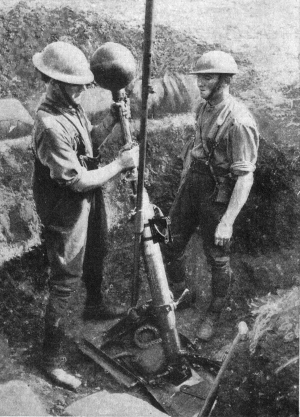
The 2 inch medium trench mortar, also known as the 2-inch howitzer, and nicknamed the "toffee apple" or "plum pudding" mortar, was a British smooth bore muzzle loading (SBML) medium trench mortar in use in World War I from mid-1915 to mid-1917. The designation "2-inch" refers to the mortar barrel, into which only the 22 in (560 mm) bomb shaft but not the bomb itself was inserted; the spherical bomb itself was actually 9 in (230 mm) in diameter and weighed 42 lb (19 kg), hence this weapon is more comparable to a standard mortar of approximately 5–6 in (130–150 mm) bore.
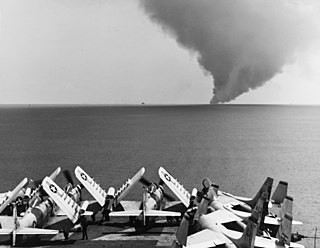
On 29 July 1967, a fire broke out on board the aircraft carrier USS Forrestal after an electrical anomaly caused a Zuni rocket on an F-4B Phantom to fire, striking an external fuel tank of an A-4 Skyhawk. The flammable jet fuel spilled across the flight deck, ignited, and triggered a chain reaction of explosions that killed 134 sailors and injured 161. At the time, Forrestal was engaged in combat operations in the Gulf of Tonkin, during the Vietnam War. The ship survived, but with damage exceeding US$72 million, not including the damage to aircraft. Future United States Senator John McCain and future four-star admiral and U.S. Pacific Fleet Commander Ronald J. Zlatoper were among the survivors. Another on-board officer, Lieutenant Tom Treanore, later returned to the ship as her commander and retired an admiral.

The Fairchild AU-23 Peacemaker is an American armed gunship, counter-insurgency, utility transport version of the Pilatus PC-6 Porter for the United States Air Force. A total of 35 were built under license in the United States by Fairchild Industries, for use during the Vietnam War in the early 1970s. All aircraft were later sold to the Royal Thai Air Force.

No. 5131 (BD) Squadron was an Explosive Ordnance Disposal (EOD) squadron of the Royal Air Force. First formed in 1943, 5131 Bomb Disposal Squadron was the Royal Air Force’s explosive ordnance disposal capability for 77 years. Its technicians were trained to deal with conventional munitions, chemical munitions and improvised explosive devices. The Squadron also responded to aircraft crashes; clearing the area of explosive risks and making any ordnance, aircraft assisted escape systems and flare countermeasures safe. During the 77-year operational history of the squadron, it saw action in World War II, the Suez conflict, the Indonesian conflict, the Cyprus invasion, the Falkland Islands war, Kosovo, Bosnia, Iraq, Afghanistan and Northern Ireland as well as Military Assistance to Police taskings in the UK.

The AB 250-2(Abwurfbehälter) was a cluster bomb used by the Luftwaffe during World War II.
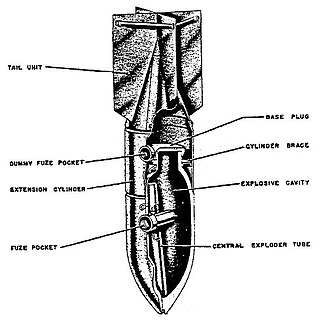
The SD 250 or thick walled explosive bomb in English was a fragmentation bomb used by the Luftwaffe during World War II.
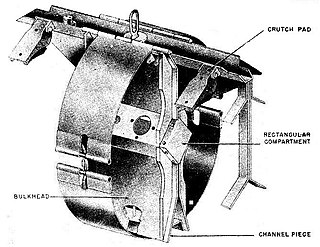
The AB 500-3A(Abwurfbehälter) was a cluster bomb used by the Luftwaffe during World War II.